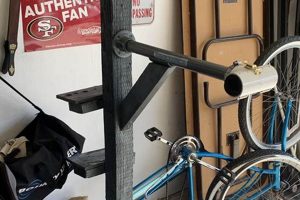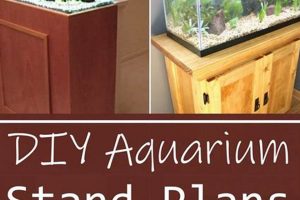A self-constructed platform designed to elevate a rain collection container is typically made from readily available materials. This structure supports the weight of a filled reservoir, facilitating gravity-fed watering and improving access to the spigot. An example involves using cinder blocks and wooden planks to create a stable base for a 55-gallon rain barrel.
Elevating a rain harvesting vessel provides several advantages. Increased elevation allows for easier filling of watering cans or connection to a soaker hose. Furthermore, an elevated position can improve water pressure for irrigation purposes, minimizing the need for electric pumps. Historically, raising water storage containers has been a method for improving water access and utilization efficiency.
The subsequent sections will detail specific design considerations, construction methods, and material options for fabricating a support structure. Durability, stability, and aesthetic integration within the landscape will be emphasized. Safety precautions and maintenance recommendations are also addressed.
Construction Considerations for Elevated Rainwater Collection Systems
The following tips provide guidance on building a secure and functional support structure for rainwater harvesting.
Tip 1: Prioritize Structural Integrity: Ensure the foundation can bear the full weight of a filled collection container. A 55-gallon barrel can weigh over 450 pounds when full; therefore, select materials and a design capable of supporting that load safely.
Tip 2: Select Weather-Resistant Materials: Opt for treated lumber, concrete blocks, or composite materials resistant to rot, insect infestation, and weathering. Untreated wood will degrade rapidly when exposed to moisture.
Tip 3: Incorporate a Level Base: Construct the foundation on a level surface to prevent uneven weight distribution and potential collapse. Use a spirit level to ensure accurate alignment during assembly.
Tip 4: Provide Adequate Drainage: Design the surrounding area to allow for drainage of spilled water, preventing water accumulation that can compromise the foundation’s stability or promote mosquito breeding.
Tip 5: Consider Accessibility: Plan for easy access to the spigot or outlet valve for filling watering cans or attaching a hose. The height of the platform should facilitate convenient water extraction.
Tip 6: Address Aesthetics: Integrate the structure aesthetically with the surrounding landscape. Paint, stain, or clad the base with decorative materials to complement the garden or yard.
Tip 7: Regularly Inspect and Maintain: Conduct periodic inspections of the structure to identify any signs of wear, damage, or instability. Address issues promptly to prevent potential accidents or structural failures.
Implementing these tips enhances the safety and longevity of the rainwater harvesting system, ensuring reliable water collection for irrigation and other non-potable uses.
The subsequent section outlines specific construction plans and designs, catering to varied skill levels and material availability.
1. Stability
Stability is a paramount concern in the design and construction of any self-made rain barrel support structure. The integrity of the entire system hinges on the platform’s ability to safely bear the considerable weight of a filled rain barrel, preventing potential structural failure and associated hazards.
- Load-Bearing Capacity
The platform must be engineered to withstand the static and dynamic loads imposed by a full rain barrel. Static load refers to the constant weight of the water and the barrel itself. Dynamic loads can arise from wind gusts or accidental impacts. The chosen materials and construction methods must provide sufficient strength to prevent deformation or collapse under these conditions. For instance, a stand constructed from untreated, undersized lumber is unlikely to provide adequate load-bearing capacity, potentially leading to catastrophic failure.
- Foundation Uniformity
The base upon which the support structure rests must be level and uniformly supportive. Uneven ground can create stress points, concentrating the load on specific areas of the platform. This can compromise the overall stability and lead to localized failure. Employing shims or leveling pads to ensure an even distribution of weight is essential for maintaining structural integrity. Failure to address ground unevenness directly undermines the effectiveness of even the most robustly constructed stand.
- Joint Integrity
The connections between individual components of the stand are critical weak points that demand careful attention. Weak or improperly secured joints can shear or separate under load, destabilizing the entire structure. Employing appropriate fasteners, such as lag bolts or screws designed for exterior use, and reinforcing joints with metal brackets or gussets can significantly enhance the stand’s overall stability. For example, using nails instead of screws in a wooden stand creates a weaker joint that is prone to loosening over time due to expansion and contraction caused by weather exposure.
- Material Selection
The intrinsic properties of the materials used in construction directly impact the stand’s overall stability. Materials with high compressive strength and resistance to deformation under load are preferable. Concrete blocks, pressure-treated lumber, and steel are common choices due to their inherent stability characteristics. Conversely, materials like plastic or thin-walled metal are generally unsuitable for load-bearing applications in this context, as they lack the necessary strength and rigidity.
In conclusion, stability is not merely a design consideration but a fundamental requirement for a functional and safe system. A well-engineered platform incorporates robust materials, sound construction techniques, and a level foundation to ensure it can reliably support the weight of the filled rain barrel over the long term, mitigating risks of collapse and enabling efficient rainwater harvesting.
2. Durability
The longevity and effectiveness of a self-constructed rainwater collection support structure are inextricably linked to its durability. Inherent to the concept is the understanding that exposure to the elements, coupled with the static load of a filled rain barrel, will relentlessly test the structural integrity of the base. Consequently, a design prioritizing longevity is not merely desirable; it is fundamentally essential for both safety and long-term cost-effectiveness. The selection of materials and construction methods directly determines the lifespan of the stand and its capacity to resist degradation from moisture, temperature fluctuations, and biological activity. A failure to address these factors proactively results in premature structural compromise and potentially hazardous conditions.
Consider, for example, two scenarios. One involves a stand constructed from untreated softwood lumber, exposed directly to the ground. In this instance, moisture absorption will rapidly lead to rot and fungal decay, compromising the structural integrity within a few seasons. Fasteners will loosen, joints will weaken, and the platform may ultimately collapse under the weight of a filled barrel. Conversely, a stand built using pressure-treated lumber, elevated slightly above ground level, and sealed with a weather-resistant coating will exhibit significantly greater resistance to degradation. The treated lumber resists fungal attack, elevation minimizes moisture exposure, and the coating provides an additional barrier against the elements. Regular inspection and maintenance, such as re-sealing the wood every few years, further extends the stand’s lifespan. Similarly, using naturally durable materials like cedar or redwood provides inherent resistance to decay.
Therefore, durability represents a critical intersection between material selection, construction technique, and environmental factors. Prioritizing weather-resistant materials, employing sound joinery practices, and providing adequate protection from moisture are necessary considerations to ensure the long-term viability of a self-made rain barrel support structure. Neglecting durability may lead to premature failure, increased maintenance costs, and potential safety hazards, ultimately undermining the sustainability goals of rainwater harvesting. The investment in durable materials and construction techniques translates directly into a more resilient and cost-effective rainwater collection system.
3. Materials
Material selection is a cornerstone of successful self-made rain barrel platform construction. The chosen materials dictate the platform’s structural integrity, durability, and overall lifespan, directly impacting its capacity to safely and reliably support a filled rainwater collection vessel under varying environmental conditions.
- Treated Lumber
Pressure-treated lumber resists rot, decay, and insect infestation, extending the lifespan of a platform subjected to constant moisture exposure. Southern Yellow Pine is a common species treated for outdoor use. Platforms constructed with untreated lumber are susceptible to rapid degradation, especially in damp environments. The cost-effectiveness of treated lumber over its lifespan makes it a frequent material choice.
- Concrete Blocks
Concrete blocks provide high compressive strength and stability, suitable for constructing a robust and long-lasting base. These blocks resist weathering and are relatively inexpensive. A concrete block base may lack aesthetic appeal, and require a stable, level surface to ensure uniform load distribution. The modular nature of concrete blocks facilitates easy assembly and customization of the platform’s dimensions.
- Composite Materials
Wood-plastic composites offer a blend of durability and aesthetic flexibility. These materials resist moisture absorption and insect damage, while mimicking the appearance of natural wood. Initial costs may be higher than traditional lumber, but the reduced maintenance requirements can offset the expense over time. Composite decking or fencing materials can be repurposed or purchased specifically for constructing a stable platform.
- Fasteners and Connectors
The type and quality of fasteners directly affect joint strength and overall structural integrity. Galvanized screws, bolts, and metal brackets resist corrosion and provide secure connections between platform components. Improper fastener selection can lead to premature joint failure, especially in outdoor environments. Using exterior-grade adhesives in conjunction with mechanical fasteners further enhances joint strength and weather resistance.
The selection of appropriate materials, considering both cost and performance characteristics, is paramount in ensuring the long-term functionality and safety of a self-constructed rain barrel support structure. Balancing structural requirements with environmental resilience and budgetary constraints is crucial for successful implementation. Each material option offers distinct advantages and disadvantages that must be carefully evaluated during the design phase.
4. Elevation
Elevation is a critical parameter in the design and implementation of a self-made rain barrel platform. The height at which the rain barrel is positioned directly influences the functionality and practicality of the entire rainwater harvesting system. Insufficient elevation may render the collected water difficult to access, hindering its utilization for irrigation or other purposes. Conversely, excessive elevation, while providing enhanced water pressure, may compromise the structural stability of the platform or introduce safety concerns. The selection of an appropriate elevation, therefore, necessitates a careful evaluation of the intended applications and the physical constraints of the installation site. The height of the platform facilitates gravity-fed water flow, a key benefit in eliminating the need for pumps to utilize stored water. For example, a platform elevating the barrel by 2 feet allows for easy filling of watering cans. Greater elevation enables connection to a soaker hose on a slightly uphill garden bed.
In practical terms, the optimal elevation is determined by the desired water pressure and the height of the intended point of use. If the collected rainwater is primarily used for filling watering cans, a modest elevation of 1-2 feet may suffice. This height allows for convenient access to the spigot without requiring excessive bending or lifting. However, if the intention is to connect the rain barrel to a drip irrigation system or a soaker hose, a higher elevation may be necessary to generate sufficient water pressure for effective irrigation. In such cases, an elevation of 3-4 feet may be required, depending on the length and diameter of the hose and the specific requirements of the irrigation system. The placement location for the water is vital for the elevation.
The impact of elevation extends beyond ease of use. A well-chosen height contributes to the overall efficiency of the rainwater harvesting system. By harnessing gravity, it reduces reliance on electricity and simplifies the process of water distribution. Conversely, insufficient elevation limits the potential applications of the collected water and necessitates the use of pumps, increasing energy consumption and system complexity. Addressing elevation challenges from the outset results in a more sustainable and user-friendly rainwater harvesting solution.
5. Drainage
Effective drainage around a self-constructed rain barrel platform is integral to its long-term stability and functionality. Water accumulation beneath or around the structure can compromise the integrity of the supporting materials, especially if wood is utilized. Prolonged exposure to moisture promotes rot, decay, and insect infestation, thereby reducing the platform’s load-bearing capacity and overall lifespan. Proper drainage mitigates these risks by diverting water away from the base, preventing saturation of the surrounding soil, and minimizing the potential for structural damage. A DIY platform built without considering drainage can experience premature failure, potentially leading to the collapse of the entire rain harvesting system. A tangible example involves a wooden platform constructed on a clay soil base. Following heavy rainfall, water pools around the base, saturating the wood and creating an environment conducive to fungal growth. Over time, the wood weakens, and the platform becomes unstable, necessitating costly repairs or replacement. The practical significance of understanding the drainage dynamics is ensuring the support structure will function for the long haul and without issues or failures.
Several methods can be implemented to ensure adequate drainage. One approach involves constructing the platform on a gravel bed. The gravel provides a permeable layer that allows water to drain away from the base, preventing pooling and reducing moisture exposure. Another technique involves sloping the ground surrounding the platform to direct water away from the structure. This can be achieved by creating a slight gradient using soil or other landscaping materials. Additionally, installing a French draina trench filled with gravel and a perforated pipecan effectively channel water away from the area. The choice of drainage method depends on the specific site conditions, soil type, and the availability of resources. Regardless of the chosen approach, regular inspection and maintenance are essential to ensure the drainage system functions optimally. This may involve clearing debris from drainage channels, removing accumulated sediment, or repairing any damage to the drainage infrastructure.
In conclusion, appropriate attention to drainage is not an ancillary consideration but a fundamental aspect of sound rain barrel platform design. By actively managing water flow around the support structure, the risk of structural degradation is significantly reduced, extending the platform’s lifespan and ensuring the reliable operation of the rainwater harvesting system. Neglecting drainage introduces preventable risks and diminishes the overall sustainability of the endeavor. Prioritization of this concept is essential for effective design and implementation.
6. Accessibility
Accessibility, in the context of a self-made rain barrel platform, refers to the ease with which individuals can utilize the collected rainwater. This encompasses physical access to the water source and the convenience of extracting it for its intended purpose. A poorly designed platform, lacking in considerations for user accessibility, can negate the benefits of rainwater harvesting by making water retrieval cumbersome or even hazardous. For instance, a platform that is excessively high without a stable step or ramp will create difficulties for individuals with mobility limitations, rendering the collected water unusable. The practical consequence is that the investment in the rain barrel and platform becomes largely ineffective, and reliance on municipal water sources continues.
The design of the platform can directly influence several key aspects of accessibility. These include the height of the spigot or outlet valve, the provision of a stable and level surface for filling containers, and the integration of features that accommodate individuals with physical limitations. A well-designed platform positions the spigot at a comfortable height, eliminating the need for excessive bending or stooping. A stable surface prevents spills and accidents during water extraction, and the inclusion of ramps or handrails enhances accessibility for all users. Furthermore, the placement of the platform itself should be carefully considered, ensuring that it is located in an area that is easily accessible from the garden or other areas where the water will be used. A platform placed in a remote or difficult-to-reach location will invariably reduce its usability and deter individuals from utilizing the collected rainwater.
In summary, accessibility is not a secondary consideration but an integral component of a functional and sustainable rainwater harvesting system. A platform designed with attention to accessibility maximizes the usability of the collected water, promoting water conservation and reducing reliance on municipal water sources. Overcoming the challenges associated with accessibility requires thoughtful planning and design, ensuring that the platform meets the needs of all users. Failure to address accessibility can render a self-made rain barrel platform ineffective and undermine the goals of water conservation.
7. Aesthetics
The aesthetic integration of a self-made rain barrel platform with its surrounding environment significantly influences its perceived value and user adoption. A visually appealing design enhances the overall landscape while a poorly executed structure can detract from it. Aesthetics is not merely superficial; it directly impacts the acceptance and continued use of the rainwater harvesting system.
- Material Harmonization
The selection of materials should complement existing landscape elements. Using natural materials like cedar or stone can create a seamless transition between the platform and its surroundings. Conversely, using starkly contrasting materials like brightly painted concrete blocks might create a visual discordance, diminishing the aesthetic appeal of the garden. This includes considering the color, texture, and form of construction materials for a cohesive design.
- Camouflage and Integration
Effective camouflage can minimize the visual impact of the platform. Integrating it into existing landscape features, such as a flower bed or a retaining wall, can make it less conspicuous. Vines or climbing plants can also be used to soften the lines of the structure and blend it with the surrounding vegetation. A design that camouflages helps users to accept the structure since it minimizes the impact in the environment.
- Form and Proportion
The shape and dimensions of the platform should be proportional to the size of the rain barrel and the surrounding landscape. A disproportionately large platform can overwhelm the space, while a too-small platform can appear flimsy or inadequate. Maintaining appropriate proportions contributes to a sense of visual balance and harmony. When the balance is attained, it is pleasing to see the structure in conjunction with the rainwater collector barrel.
- Surface Treatment and Detailing
The surface finish of the platform can significantly enhance its aesthetic appeal. Painting, staining, or cladding the structure with decorative materials can transform a utilitarian object into a visually pleasing feature. Paying attention to details, such as the design of joints and edges, further elevates the overall aesthetic quality. The extra step for details improves the aesthetic of the finished product.
Integrating aesthetic considerations into the design and construction of a self-made rain barrel platform is not merely an optional enhancement; it is a crucial factor in promoting its acceptance and ensuring its long-term integration into the landscape. A visually appealing platform is more likely to be appreciated and maintained, contributing to the sustainability of the rainwater harvesting system.
Frequently Asked Questions
This section addresses common inquiries regarding the design, construction, and maintenance of self-made rain barrel platforms. The information presented aims to provide clarity and guidance for individuals undertaking this project.
Question 1: What is the minimum load-bearing capacity required for a typical platform?
The platform’s load-bearing capacity should exceed the maximum weight of a filled rain barrel. A standard 55-gallon barrel, when full, can weigh over 450 pounds. Therefore, the platform must be engineered to safely support at least this weight, with an additional safety margin to account for dynamic loads and potential material degradation.
Question 2: Which materials offer the best combination of durability and affordability?
Pressure-treated lumber offers a balance of durability and cost-effectiveness. It resists rot, decay, and insect infestation, extending the lifespan of the platform. Concrete blocks also provide a durable and relatively inexpensive alternative, although aesthetic considerations may warrant additional cladding or surface treatments.
Question 3: How can the platform’s stability be ensured on uneven ground?
Prior to construction, the ground surface should be leveled and compacted. If the ground remains uneven, concrete pavers or shims can be used to create a stable base for the platform’s foundation. Ensuring uniform weight distribution is crucial for preventing structural instability.
Question 4: What is the recommended elevation for facilitating gravity-fed water flow?
The optimal elevation depends on the intended use of the collected water. For filling watering cans, a height of 1-2 feet may suffice. For connecting to a drip irrigation system, an elevation of 3-4 feet may be necessary to generate sufficient water pressure. The user is directed to test the pressure prior to installation.
Question 5: What measures can be taken to prevent water accumulation around the platform?
Effective drainage can be achieved by constructing the platform on a gravel bed, sloping the surrounding ground to direct water away from the structure, or installing a French drain. These measures minimize moisture exposure and prevent potential damage to the platform’s supporting materials. The chosen material should be compatible with drainage systems.
Question 6: How frequently should the platform be inspected for signs of wear or damage?
The platform should be inspected at least twice annually, preferably in the spring and fall. These inspections should focus on identifying any signs of rot, decay, insect infestation, or structural instability. Promptly addressing any issues identified during these inspections can prevent further damage and extend the platform’s lifespan.
In conclusion, the information presented above provides essential guidance for constructing and maintaining a functional and durable structure. Consideration of these points is crucial for guaranteeing the safety and efficacy of rainwater harvesting practices.
The following portion will describe advanced design and material considerations, including safety protocols and weather-proofing techniques.
DIY Rain Barrel Stand
The preceding sections have explored the multifaceted considerations inherent in the construction of a platform for rainwater collection. From material selection and load-bearing capacity to drainage and aesthetic integration, the creation of a functional and durable structure demands a comprehensive understanding of both structural engineering principles and environmental factors. The information presented aims to equip individuals with the knowledge necessary to build a safe and effective system. This involves assessing terrain, waterflow and weight distribution prior to project planning.
The responsible implementation of rainwater harvesting practices hinges upon a commitment to sound construction techniques and regular maintenance. Continued adherence to these principles will ensure the long-term viability of self-made rain barrel platforms and contribute to the sustainable management of water resources. Only when due diligence is executed will the user appreciate the benefits of this product.







